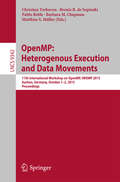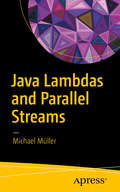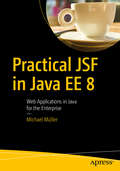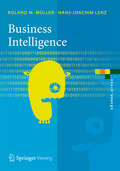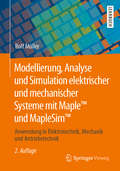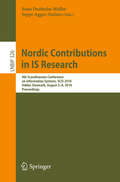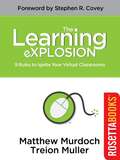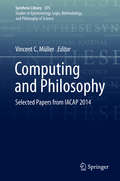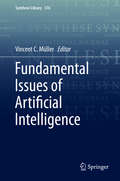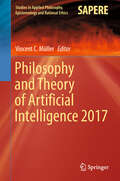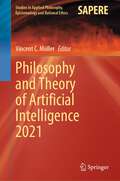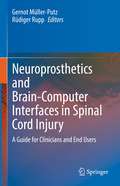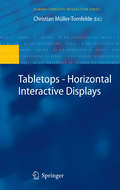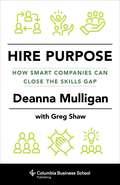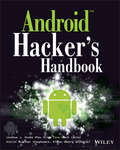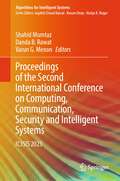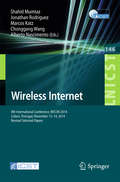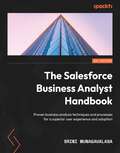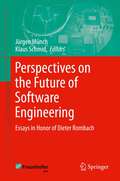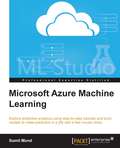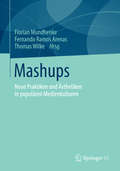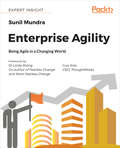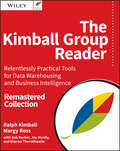- Table View
- List View
OpenMP: Heterogenous Execution and Data Movements
by Matthias S. Müller Barbara M. Chapman Pablo Reble Bronis R. de Supinski Christian TerbovenThis book constitutes the refereed proceedings of the 11th International Workshop on OpenMP, held in Aachen, Germany, in October 2015. The 19 technical full papers presented were carefully reviewed and selected from 22 submissions. The papers are organized in topical sections on applications, accelerator applications, tools, extensions, compiler and runtime, and energy.
Java Lambdas and Parallel Streams
by Michael MüllerThis compact book introduces the concepts of Java lambdas and parallel streams in a concise form. It begins by introducing new supporting features such as functional interfaces, default methods and more. After this, the author demonstrates how streams can be parallelized in a very simple way—within certain limits, no knowledge about the thread management is needed. Nevertheless, some basic elements in the context of parallelism need to be considered. Here, the book provides a variety of information and best practices.What You Will LearnMaster lambdas and streamsWork with the default methodHarness streams and the stream() function Use Stream and SpliteratorTake advantage of parallel streamsWork with collectors and concurrencyWho This Book Is ForExperienced Java programmers and developers.div>
Practical JSF in Java EE 8: Web Applications in Java for the Enterprise
by Michael MüllerMaster the Java EE 8 and JSF (JavaServer Faces) APIs and web framework with this practical, projects-driven guide to web development. This book combines theoretical background with a practical approach by building four real-world applications. By developing these JSF web applications, you'll take a tour through the other Java EE technologies such as JPA, CDI, Security, WebSockets, and more.In Practical JSF in Java EE 8, you will learn to use the JavaServer Faces web framework in Java EE 8 to easily construct a web-based user interface from a set of reusable components. Next, you add JSF event handling and then link to a database, persist data, and add security and the other bells and whistles that the Java EE 8 platform has to offer.After reading this book you will have a good foundation in Java-based web development and will have increased your proficiency in sophisticated Java EE 8 web development using the JSF framework.What You Will Learn Use the Java EE 8 and the JavaServer Faces APIs to build Java-based web applications through four practical real-world case studies Process user input with JSF and the expression language by building a calculator application Persist data using JSF templating and Java Persistence to manage an inventory of books Create and manage an alumni database using JSF, Ajax, web services and Java EE 8's security features. Who This Book Is For Those new to Java EE 8 and JSF. Some prior experience with Java is recommended.
Business Intelligence (eXamen.press)
by Roland M. Müller Hans-Joachim LenzDas Buch befasst sich mit der Bereitstellung von Daten und Verfahren für analytische Zwecke (Planung, Entscheidung, Controlling sowie Fehlerrückverfolgung) in Unternehmen sowie der notwendigen Rechenleistungen. Die Autoren erläutern die Datenbereitstellung mittels Data Warehouses, Auswertung mittels OLAP-Operationalität und geeignete Verfahren der explorativen Datenanalyse. Bei den Verfahren des Operations Research werden Simulation und Lineare Optimierung dargestellt. Neben erfolgreichen Anwendungen und Fallstudien steht das Verständnis der zugrundeliegenden Algorithmen und Datenstrukturen, die für das Erlernen der BI-Verfahren zwingend notwendig sind, im Vordergrund.
Modellierung, Analyse und Simulation elektrischer und mechanischer Systeme mit Maple™ und MapleSim™: Anwendung in Elektrotechnik, Mechanik und Antriebstechnik
by Rolf MüllerDieses Lehrbuch vermittelt Grundwissen zur Lösung von Problemen der Elektrotechnik, der Antriebstechnik und der Mechatronik mit Hilfe des mathematischen Expertensystems Maple™ und des objektorientierten Simulationssystems MapleSim™. Der Autor stellt zunächst Maple™ in konzentrierter Form vor. Danach geht er ausführlich auf die Ermittlung analytischer und numerischer Lösungen von Differentialgleichungen mit Maple™ ein. Der Modellierung und Analyse elektrischer und mechanischer Systeme mit Unterstützung durch Maple™ sowie komplexeren Anwendungsbeispielen sind die folgenden Kapitel des Buches gewidmet. Ausführlich beschrieben werden auch das objektorientierte Modellieren und Simulieren mit MapleSim™ und die Zusammenarbeit von Maple™ mit MapleSim™, Matlab™ und Scilab™.
Nordic Contributions in IS Research: 9th Scandinavian Conference on Information Systems, SCIS 2018, Odder, Denmark, August 5–8, 2018, Proceedings (Lecture Notes in Business Information Processing #326)
by Sune Dueholm Müller Jeppe Agger NielsenThis book constitutes the proceedings of the 9th Scandinavian Conference on Information Systems, SCIS 2018, held in Odder, Denmark in August 2018. The 5 full papers presented in this volume were carefully reviewed and selected from 18 submissions. They focus on digital adaptation, disruption, and survival as overall themes, and deal with issues related to challenges, obstacles, and unintended consequences that require an understanding of the role of digital technologies in organizations.
The Learning Explosion
by Treion Muller Matthew MurdochMaking the move to online teaching and learning can be challenging, and professionals and laypeople alike want to know the best ways to accomplish the switchover without sacrificing the quality of the material that is being taught. The ultimate challenge is how one transfers the in-person teaching experience and to retain the quality of that experience in the online world in a way that maintains its original integrity. Ultimately what we want is an experience that is challenging and just as engaging as the experience one would get in a live classroom. This book helps readers learn how to transfer their in-person classroom experience and skills to the virtual classroom.
Computing and Philosophy: Selected Papers from IACAP 2014 (Synthese Library #375)
by Vincent C. MüllerThis volume offers very selected papers from the 2014 conference of the "International Association for Computing and Philosophy" (IACAP) - a conference tradition of 28 years. The theme of the papers is the two-way relation between computing technologies and philosophical questions: Computing technologies both raise new philosophical questions, and shed light on traditional philosophical problems. The chapters cover: 1) philosophy of computing, 2) philosophy of computer science & discovery, 3) philosophy of cognition & intelligence, 4) computing & society, and 5) ethics of computation.
Fundamental Issues of Artificial Intelligence
by Vincent C. MüllerThis volume offers a look at the fundamentalissues of present and future AI, especially from cognitive science, computerscience, neuroscience and philosophy. This work examines the conditionsfor artificial intelligence, how these relate to the conditions for intelligencein humans and other natural agents, as well as ethical and societal problemsthat artificial intelligence raises or will raise. The key issues this volume investigates include the relation of AI andcognitive science, ethics of AI and robotics, brain emulation andsimulation, hybrid systems and cyborgs, intelligence and intelligence testing,interactive systems, multi-agent systems, and super intelligence. Based on the 2nd conference on "Theory and Philosophy of ArtificialIntelligence" held in Oxford, the volume includes prominentresearchers within the field from around the world.
Fundamental Issues of Artificial Intelligence (Synthese Library #376)
by Vincent C. MüllerThis volume offers a look at the fundamental issues of present and future AI, especially from cognitive science, computer science, neuroscience and philosophy. This work examines the conditions for artificial intelligence, how these relate to the conditions for intelligence in humans and other natural agents, as well as ethical and societal problems that artificial intelligence raises or will raise. The key issues this volume investigates include the relation of AI and cognitive science, ethics of AI and robotics, brain emulation and simulation, hybrid systems and cyborgs, intelligence and intelligence testing, interactive systems, multi-agent systems, and super intelligence. Based on the 2nd conference on “Theory and Philosophy of Artificial Intelligence” held in Oxford, the volume includes prominent researchers within the field from around the world.
Philosophy and Theory of Artificial Intelligence 2017 (Studies in Applied Philosophy, Epistemology and Rational Ethics #44)
by Vincent C. MüllerThis book reports on the results of the third edition of the premier conference in the field of philosophy of artificial intelligence, PT-AI 2017, held on November 4 - 5, 2017 at the University of Leeds, UK. It covers: advanced knowledge on key AI concepts, including complexity, computation, creativity, embodiment, representation and superintelligence; cutting-edge ethical issues, such as the AI impact on human dignity and society, responsibilities and rights of machines, as well as AI threats to humanity and AI safety; and cutting-edge developments in techniques to achieve AI, including machine learning, neural networks, dynamical systems. The book also discusses important applications of AI, including big data analytics, expert systems, cognitive architectures, and robotics. It offers a timely, yet very comprehensive snapshot of what is going on in the field of AI, especially at the interfaces between philosophy, cognitive science, ethics and computing.
Philosophy and Theory of Artificial Intelligence 2021 (Studies in Applied Philosophy, Epistemology and Rational Ethics #63)
by Vincent C. MüllerThis book gathers contributions from the fourth edition of the Conference on "Philosophy and Theory of Artificial Intelligence" (PT-AI), held on 27-28th of September 2021 at Chalmers University of Technology, in Gothenburg, Sweden. It covers topics at the interface between philosophy, cognitive science, ethics and computing. It discusses advanced theories fostering the understanding of human cognition, human autonomy, dignity and morality, and the development of corresponding artificial cognitive structures, analyzing important aspects of the relationship between humans and AI systems, including the ethics of AI. This book offers a thought-provoking snapshot of what is currently going on, and what are the main challenges, in the multidisciplinary field of the philosophy of artificial intelligence.
Neuroprosthetics and Brain-Computer Interfaces in Spinal Cord Injury: A Guide for Clinicians and End Users
by Gernot Müller-Putz Rüdiger RuppThis book provides a comprehensive overview of the current state of the art of practical applications of neuroprosthesis based on functional electrical stimulation for restoration of motor functions lost by spinal cord injury and discusses the use of brain-computer interfaces for their control.The book covers numerous topics starting with basics about spinal cord injury, electrical stimulation, electrical brain signals and brain-computer interfaces. It continues with an overview of neuroprosthetic solutions for different purposes and non-invasive and invasive brain-computer interface implementations and presents clinical use cases and practical applications of BCIs. Finally, the authors give an outlook on cutting edge research with a high potential for clinical translation in the near future.All authors committed themselves to use easy-to-understand language and to avoid very specific information, focusing instead on the essential aspects. This makes this book an ideal choice not only for researchers and clinicians at all stages of their education interested in the topic of brain-computer interface-controlled neuroprostheses, but also for end users and their caregivers who want to inform themselves about the current technological possibilities to improve paralyzed motor functions.
Tabletops - Horizontal Interactive Displays
by Christian Müller-TomfeldeThis book is the first attempt to bring together current research findings in the domain of interactive horizontal displays. The novel compilation will integrate and summarise findings from the most important international tabletop research teams. It will provide a state-of-the art overview of this research domain and therefore allow for discussion of emerging and future directions in research and technology of interactive horizontal displays. Latest advances in interaction and software technologies and their increasing availability beyond research labs, refuels the interest in interactive horizontal displays. In the early 1990s Mark Weiser's vision of Ubiquitous Computing redefined the notion of Human Computer Interaction. Interaction was no longer considered to happen only with standard desktop computers but also with elements of their environment. This book is structured in three major areas: 'under', 'on/above' and 'around' tabletops. These areas are associated with different research disciplines such as Hardware/Software and Computer Science, Human Computer Interaction (HCI) and Computer Supported Collaborative Work (CSCW). However, the comprehensive and compelling presentation of the topic of the book results from its interdisciplinary character. The book addresses fellow researchers who are interested in this domain and practitioners considering interactive tabletops in real-world projects. It will also be a useful introduction into tabletop research that can be used for the academic curriculum.
Hire Purpose: How Smart Companies Can Close the Skills Gap
by Deanna Mulligan Greg ShawThe future of work is already here, and what this future looks like must be a pressing concern for the current generation of leaders in both the private and public sectors. In the next ten to fifteen years, rapid change in a post-pandemic world and emerging technology will revolutionize nearly every job, eliminate some, and create new forms of work that we have yet to imagine. How can we survive and thrive in the face of such drastic change?Deanna Mulligan offers a practical, broad-minded look at the effects of workplace evolution and automation and why the private sector needs to lead the charge in shaping a values-based response. With a focus on the power of education, Mulligan proposes that the solutions to workforce upheaval lie in reskilling and retraining for individuals and companies adapting to rapid change. By creating lifelong learning opportunities that break down boundaries between the classroom and the workplace, businesses can foster personal and career well-being and growth for their employees. Drawing on her own experiences, historical examples, and reports from the frontiers where these issues are unfolding, Mulligan details how business leaders can prepare for and respond to technological disruption. Providing a framework for concrete and meaningful action, Hire Purpose is an essential read about the transformations that will shape the next decade and beyond.
Android Hacker's Handbook
by Collin Mulliner Georg Wicherski Pau Oliva Fora Joshua J. Drake Zach Lanier Stephen A. RidleyThe first comprehensive guide to discovering and preventingattacks on the Android OSAs the Android operating system continues to increase its shareof the smartphone market, smartphone hacking remains a growingthreat. Written by experts who rank among the world's foremostAndroid security researchers, this book presents vulnerabilitydiscovery, analysis, and exploitation tools for the good guys.Following a detailed explanation of how the Android OS works andits overall security architecture, the authors examine howvulnerabilities can be discovered and exploits developed forvarious system components, preparing you to defend againstthem.If you are a mobile device administrator, security researcher,Android app developer, or consultant responsible for evaluatingAndroid security, you will find this guide is essential to yourtoolbox.A crack team of leading Android security researchers explainAndroid security risks, security design and architecture, rooting,fuzz testing, and vulnerability analysisCovers Android application building blocks and security as wellas debugging and auditing Android appsPrepares mobile device administrators, security researchers,Android app developers, and security consultants to defend Androidsystems against attackAndroid Hacker's Handbook is the first comprehensiveresource for IT professionals charged with smartphonesecurity.
Proceedings of the Second International Conference on Computing, Communication, Security and Intelligent Systems: IC3SIS 2023 (Algorithms for Intelligent Systems)
by Shahid Mumtaz Danda B. Rawat Varun G. MenonThis book presents the best-selected research papers presented at the Second International Conference on Computing, Communication, Security & Intelligent Systems (IC3SIS 2023), organized by SCMS School of Engineering and Technology, Kochi, on July 06–07, 2023. It discusses the latest technologies in communication and intelligent systems, covering various areas of computing, such as advanced computing, communication and networking, intelligent systems and analytics, 5G and IoT, soft computing, and cybersecurity in general. Featuring work by leading researchers and technocrats, the book serves as a valuable reference resource for young researchers, academics, and industry practitioners.
Wireless Internet
by Shahid Mumtaz Jonathan Rodriguez Marcos Katz Chonggang Wang Alberto NascimentoThis book constitutes the thoroughly refereed post-conference proceedings of the 8th International Conference on Wireless Internet, WICON 2014, held in Lisbon, Portugal, in November 2014. The 45 revised full papers were carefully reviewed and selected from numerous submissions. The papers cover topics such as 5G mobile communications, Internet of Things (IoT), super Wi-Fi and V2V/V21.
The Salesforce Business Analyst Handbook: Proven business analysis techniques and processes for a superior user experience and adoption
by Srini MunagavalasaBecome a proficient Salesforce business analyst with the help of expert recommendations, techniques, best practices, and practical advicePurchase of the print or Kindle book includes a free eBook in the PDF format.Key FeaturesLearn the intricacies and nuances of every stage of a project's implementationDiscover real-world examples, tips, and tricks that you can apply to any Salesforce projectOvercome the challenges inherent in user interaction and improve your customer experienceBook DescriptionSalesforce business analysis skills are in high demand, and there are scant resources to satisfy this demand. This practical guide for business analysts contains all the tools, techniques, and processes needed to create business value and improve user adoption.The Salesforce Business Analyst Handbook begins with the most crucial element of any business analysis activity: identifying business requirements. You'll learn how to use tacit business analysis and Salesforce system analysis skills to rank and stack all requirements as well as get buy-in from stakeholders. Once you understand the requirements, you'll work on transforming them into working software via prototyping, mockups, and wireframing. But what good is a product if the customer cannot use it? To help you achieve that, this book will discuss various testing strategies and show you how to tailor testing scenarios that align with business requirements documents. Toward the end, you'll find out how to create easy-to-use training material for your customers and focus on post-production support – one of the most critical phases. Your customers will stay with you if you support them when they need it!By the end of this Salesforce book, you'll be able to successfully navigate every phase of a project and confidently apply your new knowledge in your own Salesforce implementations.What you will learnCreate a roadmap to deliver a set of high-level requirementsPrioritize requirements according to their business valueIdentify opportunities for improvement in process flowsCommunicate your solution design via conference room pilotsConstruct a requirements traceability matrixConduct user acceptance tests and system integration testsDevelop training artifacts so your customers can easily use your systemImplement a post-production support model to retain your customersWho this book is forThis book is for intermediate- to senior-level business analysts with a basic understanding of Salesforce CRM software or any CRM technology who want to learn proven business analysis techniques to set their business up for success.
Perspectives on the Future of Software Engineering
by Jürgen Münch Klaus SchmidThe dependence on quality software in all areas of life is what makes software engineering a key discipline for today's society. Thus, over the last few decades it has been increasingly recognized that it is particularly important to demonstrate the value of software engineering methods in real-world environments, a task which is the focus of empirical software engineering. One of the leading protagonists of this discipline worldwide is Prof. Dr. Dr. h.c. Dieter Rombach, who dedicated his entire career to empirical software engineering. For his many important contributions to the field he has received numerous awards and recognitions, including the U.S. National Science Foundation's Presidential Young Investigator Award and the Cross of the Order of Merit of the Federal Republic of Germany. He is a Fellow of both the ACM and the IEEE Computer Society. This book, published in honor of his 60th birthday, is dedicated to Dieter Rombach and his contributions to software engineering in general, as well as to empirical software engineering in particular. This book presents invited contributions from a number of the most internationally renowned software engineering researchers like Victor Basili, Barry Boehm, Manfred Broy, Carlo Ghezzi, Michael Jackson, Leon Osterweil, and, of course, by Dieter Rombach himself. Several key experts from the Fraunhofer IESE, the institute founded and led by Dieter Rombach, also contributed to the book. The contributions summarize some of the most important trends in software engineering today and outline a vision for the future of the field. The book is structured into three main parts. The first part focuses on the classical foundations of software engineering, such as notations, architecture, and processes, while the second addresses empirical software engineering in particular as the core field of Dieter Rombach's contributions. Finally, the third part discusses a broad vision for the future of software engineering.
CLEAN: CO2 Large-Scale Enhanced Gas Recovery in the Altmark Natural Gas Field - GEOTECHNOLOGIEN Science Report No. 19 (Advanced Technologies in Earth Sciences)
by Ute Münch Michael KühnThe project CLEAN (CO2 Large-Scale Enhanced Gas Recovery in the Altmark Natural Gas Field) provides site specific knowledge for a potential future pilot project. This contributed volume gives an overview and final results of the entire project which is finalized to the end of 2012.
Microsoft Azure Machine Learning
by Sumit MundThe book is intended for those who want to learn how to use Azure Machine Learning. Perhaps you already know a bit about Machine Learning, but have never used ML Studio in Azure; or perhaps you are an absolute newbie. In either case, this book will get you up-and-running quickly.
Mashups
by Florian Mundhenke Fernando Ramos Arenas Thomas WilkeMashup hat sich als Begriff eingebürgert für auditiv, visuell, audiovisuell ,,vermischte" Neuarrangements, Collagen, Bricolagen in der Musik, in Videos, in Computerspielen, in der (aktuellen Medien-)Kunst, in der Architektur. Es handelt sich um eine Verbindung heterogener Elemente, die etwas (scheinbar) Neues hervorbringen. Im Internet verbinden Websites unterschiedliche Elemente (beispielsweise Musik, Video, Hyperlinks) mit unterschiedlichen Funktionen. Ausgangspunkt für diesen Band ist die These, dass es einerseits mediale und kulturelle Techniken gibt, die diese Form des Mischgenres erst ermöglichen. Andererseits muss berücksichtigt werden, dass die mediale Kompetenz der User exponentiell angestiegen ist und weiter ansteigt. Der Band geht unter anderem der Frage nach, inwieweit es sich bei Mashups um eine qualitativ neue Form der Aneignung und/oder nur eine produktive Auseinandersetzung mit medialen Angeboten handelt.
Enterprise Agility: Being Agile in a Changing World
by Sunil MundraEnterprise Agility is practical framework for enhancing Agility and equipping your company with the tools to survive. Key Features● Prepare your company to navigate the rapidly-moving business world● Enhance Agility in every component of your organization● Build a framework that meets the unique requirements of your enterpriseBook DescriptionThe biggest challenge enterprises face today is dealing with fast-paced change in all spheres of business. Enterprise Agility shows how an enterprise can address this challenge head on and thrive in the dynamic environment. Avoiding the mechanistic construction of existing enterprises that focus on predictability and certainty, Enterprise Agility delivers practical advice for responding and adapting to the scale and accelerating pace of disruptive change in the business environment.Agility is a fundamental shift in thinking about how enterprises work to effectively deal with disruptive changes in the business environment. The core belief underlying agility is that enterprises are open and living systems. These living systems, also known as complex adaptive systems (CAS), are ideally suited to deal with change very effectively.Agility is to enterprises what health is to humans. There are some foundational principles that can be broadly applied, but the definition of healthy is very specific to each individual. Enterprise Agility takes a similar approach with regard to agility: it suggests foundational practices to improve the overall health of the body—culture, mindset, and leadership—and the health of its various organs: people, process, governance, structure, technology, and customers. The book also suggests a practical framework to create a plan to enhance agility.What you will learnDrive agility-oriented change across the enterpriseUnderstand why agility matters (more than ever) to modern enterprises Adopt and influence an Agile mindset in your teams and in your organization Understand the concept of a CAS and how to model enterprise and leadership behaviors on CAS characteristics to enhance enterprise agility Understand and convey the differences between Agile and true enterprise agility Create an enterprise-specific action plan to enhance agility Become a champion for enterprise agilityRecognize the advantages and challenges of distributed teams, and how Agile ways of working can remedy the rough spotsEnable and motivate your IT partners to adopt Agile ways of workingWho this book is forEnterprise Agility is a tool for anyone with the motivation to influence outcomes in an enterprise, who aspires to improve Agility. Readers from the following backgrounds will benefit: chief executive officer, chief information officer, people/human resource director, information technology director, head of change program, head of transformation, and Agile coach/consultant.
The Kimball Group Reader
by Joy Mundy Bob Becker Margy Ross Ralph Kimball Warren ThornthwaiteAn unparalleled collection of recommended guidelines for data warehousing and business intelligence pioneered by Ralph Kimball and his team of colleagues from the Kimball Group.Recognized and respected throughout the world as the most influential leaders in the data warehousing industry, Ralph Kimball and the Kimball Group have written articles covering more than 250 topics that define the field of data warehousing. For the first time, the Kimball Group's incomparable advice, design tips, and best practices have been gathered in this remarkable collection of articles, which spans a decade of data warehousing innovation.Each group of articles is introduced with original commentaries that explain their role in the overall lifecycle methodology developed by the Kimball Group. These practical, hands-on articles are fully updated to reflect current practices and terminology and cover the complete lifecycle--including project planning, requirements gathering, dimensional modeling, ETL, and business intelligence and analytics.This easily referenced collection is nothing less than vital if you are involved with data warehousing or business intelligence in any capacity.
